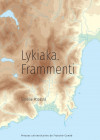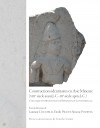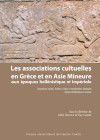
- Résumé
-
La Lydie, entre côte égéenne et plateau anatolien, associée depuis l’Antiquité au Pactole qui charriait l’or du Tmolos et à la richesse de Crésus, peuplée de Lydiens et de Méoniens, marquée par la présence perse, grecque, romaine, puis byzantine, a attiré l’attention des chercheurs depuis la fin du xviiie siècle. Cet ouvrage a pour objectif d’élargir la chronologie des études lydiennes de la période protohistorique au début de la période byzantine et de rassembler les contributions de chercheurs et d’universitaires internationaux réunis dans un éventail large de disciplines, histoire, archéologie, épigraphie, numismatique, et selon différentes perspectives. Les sujets abordés portent sur la société, les structures sociales, les aspects militaires, l’économie, la religion, les arts, l’architecture et la culture matérielle. Cette approche diachronique permet notamment d’interroger les permanences et les ruptures entre les périodes hellénistique, romaine et byzantine et celles qui les ont précédées.
- Sommaire
-
Table of contents
List of figures
List of abbreviations
Foreword
Antonio Gonzales
An introduction to Lydian studies
Ergün Laflı, Guy Labarre
Part I: Lydia in the third and second millennia B.C.
1 Protohistorical excavations at Hastane Höyük in Akhisar
Nihal Akıllı
2 Aššuwa, ᾿Ασία and the land of Lydians
Michele R. Cataudella,
Part II: Historical and other aspects of the Lydian period and the early Lydians
3 Chronology of Lydian dynasties
Alexandar Portalsky
4 Malis: a new Lydian goddess
Annick Payne, David Sasseville
5 Lefs: a Greek god in Lydian disguise. Ζευσις: a Lydian god in Greek disguise, and some Luwian gods too
Diether Schürr
6 Determining the value of the arrow-sign in Phrygian and Lydian
Fred C. Woudhuizen (†)
7 Influencing Lydia: the “Kybele Shrine” from Sardis in its Near Eastern and Greek
Contexts
Tamás Péter Kisbali
8 Some remarks on the Persian Royal Road (Herodotus V.52–54)
Yanis Pikoulas (†)
9 Diodorus and the Halys oracle
Annalisa Paradiso
10 The poet Pindar and Lydian Pelops
James Roy
11 Lydian seals from the western Pontic area
Costel Chiriac, Lucian Munteanu
12 “Who is Gyges?” once again: assessing the Carian connections of the first Mermnad king of Lydia
Liviu Mihail Iancu
13 The Artemis cult in Lydia and the Lydian Girls Choir: a political evaluation
Ayşen Sina
14 Pissuthnes, satrap of Lydia
Cinzia Susanna Bearzot
15 Lydian and Lycian arts in the context of Achaemenid Anatolia: a comparative approach
Fabienne Colas-Rannou
16 Replicating the Lydian treasure from a Turkish perspective
Ergün Laflı, Maurizio Buora
Part III: Historical and other aspects on Hellenistic and Roman Lydia
17 The Greek cities of Lydia during the First Mithridatic War (89–85 B.C.)
Fabrice Delrieux
18 The historical geography of Hellenistic and Imperial Lydia: the literary and numismatic evidence
Pierre-Oliver Hochard
19 Lydia in proverbs, idiomatic expressions, and exemplary Latin stories
Étienne Wolff
20 Heleis: a chief physician in Roman Lydia
Gaetano Arena
21 Medicine in Roman Lydia: a close relationship with imperial power
Margherita G. Cassia
22 Remarks on the imperial cult of Lydian Philadelphia based on classical literary sources
Hüseyin Üreten, Ömer Güngörmüş
23 The cult of Men in Lydia
Guy Labarre
24 An amazing oracle of Apollo of Claros and the question of the supreme god (Macrobius, Saturnalia I.18.20): Zeus, Hades, Helios, Dionysos, and Iaô
Charles Guittard
Part IV: Material culture of Hellenistic and Roman Lydia
25 A preliminary report on the recent archaeological discoveries in Lydia and the Upper Cayster Valley
Ergün Laflı
26 Building inscriptions from Roman Lydia
Maria Kantirea
27 Anatolian koine of burial practices: transformation of elite burials
Erik Hrnčiarik, Lucia Nováková
28 A preliminary report on the Roman pottery from Tabae
Oğuz Koçyiğit
29 The use of Roman fired bricks in Lydia and neighbouring regions
Julia Cecile Martin
30 Arms factories at Sardis and the supply of Roman eastern auxiliaries
Damien Glad
31 An archaeological note on Saittai
Enes Hançer
Part V: Early Byzantine Lydia
32 A contribution to the study of Lydia in the Early Byzantine period
Dimitris P. Drakoulis
33 The Early Byzantine province of Lydia based on sigillographic evidence
Werner Seibt
34 The relation of Priscianus of Lydia to Byzantium during the wars of Justinian I with the Sassanian empire
Katarzyna Maksymiuk
Part VI: Varia anatolica occidentalia
35 Ephesian amphorae in Rome in the imperial period
Giorgio Rizzo
36 Trade from Chios and Phocaea (fourth–seventh century A.D.) between written and archaelogical sources: a methodological approach
Daniele Tinterri
Part VII: Selected abstracts on recent research in Lydia
37 Geoarchaeological-paleogeographical observations on Hypaepa and its surroundings in southwestern Lydia
Serdar Vardar
38 The Hittites in Lydia
Ahmet Ünal
39 Three new sites in southeastern Lydia: Kapancık, Gerdekkayası, and Ören
Harun Oy
40 Electrum coins from Lydia and the surrounding area in the collections of the Numismatic Museum in Athens
George Kakavas
41 Lydian personal names and the question of Lydian ethno-linguistic identity
Rostislav Oreshko
42 New examples of Archaic architectural terracottas from Lydia
Sedat Akkurnaz
43 Anatolian pottery from Panticapaeum
Natalia S. Astashova
44 A Lydian tale about the Etruscans: the migration of Tyrrhenos to the west
Dominique Briquel
45 Evaluation of burial customs in Lydia in the light of the finds from the necropolis of Tralles
Arzu Özver
46 Family structure in Roman Lydia
Marijana Ricl
47 Anatolian imports in Slovenia
Verena Perko, Tina Žerjal
48 Brickwork patterns on Church at Sardis: structure and meaning
Jasmina S. Ćirić
Abstracts and keywords in English / Türkçe Özetler ve Anahtar Kelimeler
- Auteur(s)
-
Ergün LAFLI (dir.)Guy LABARRE (dir.)Chercheurs et enseignants-chercheurs issus d’universités de différents pays : Allemagne, Angleterre, Autriche, France, Grèce, Italie, Pologne, Roumanie, Serbie, Slovaquie, Slovénie, Suisse, Turquie.
- Public
-
Public étudiant (licence, master, doctorat), public enseignant, monde de la recherche.
- éléments téléchargeables
- Recensions et revues de presse
- Soutien(s)
-
Publié avec le concours de l’Institut des Sciences et Techniques de l’Antiquité (UFC)












